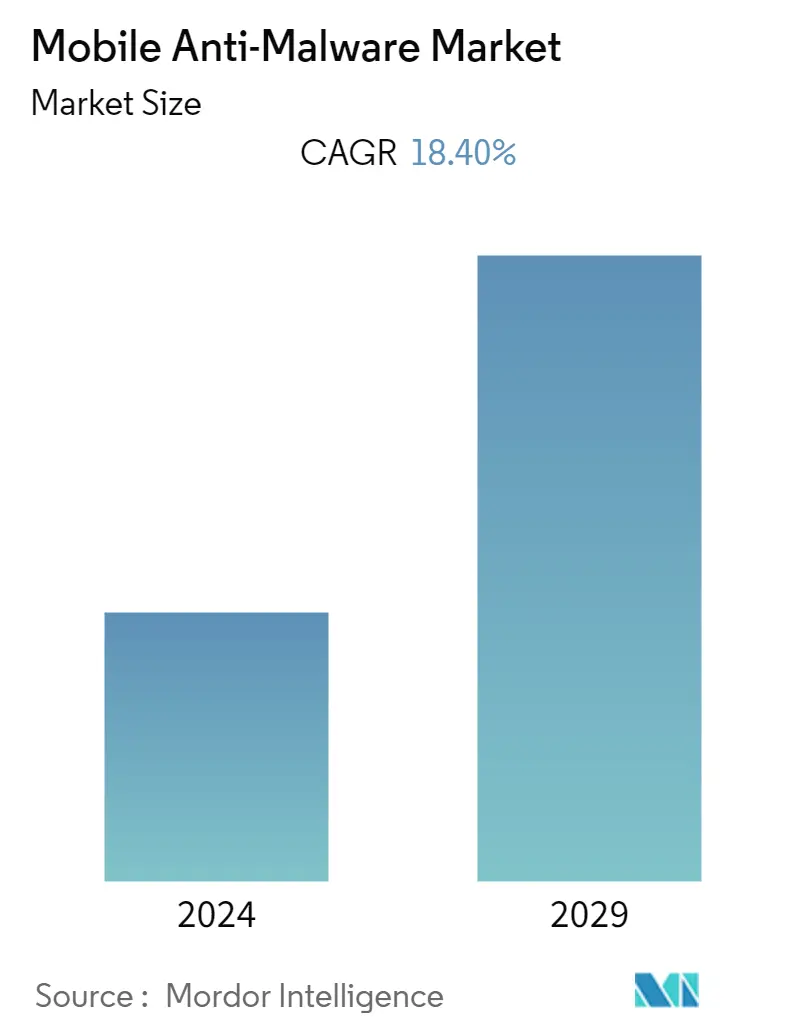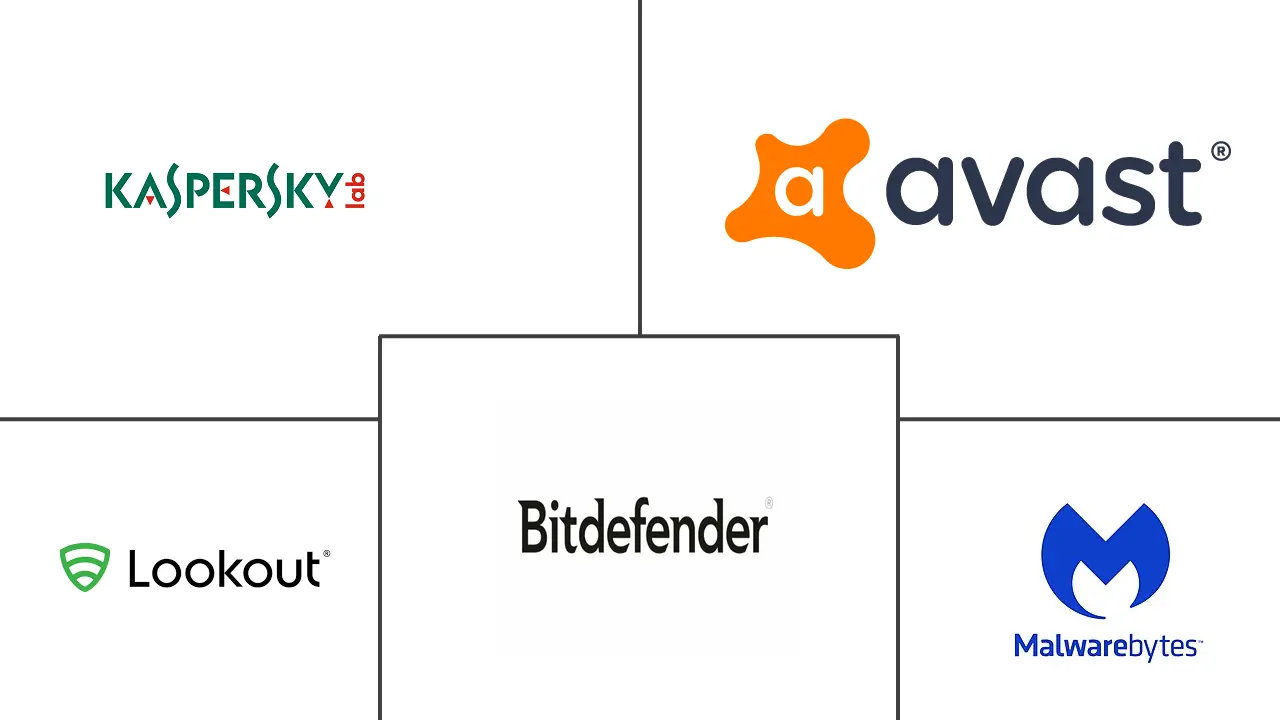Market Size of Mobile Anti-Malware Industry

| Study Period | 2019 - 2029 |
| Base Year For Estimation | 2023 |
| CAGR | 18.40 % |
| Fastest Growing Market | Asia-Pacific |
| Largest Market | Asia-Pacific |
| Market Concentration | Low |
Major Players
*Disclaimer: Major Players sorted in no particular order |
Mobile Anti-Malware Market Analysis
The mobile anti-malware market is poised to register a CAGR of 18.4% in the upcoming 5 years. The growing use of BYOD in enterprises for factors such as enabling mobile workstations, convenience, and talent retention is boosting the demand for mobile anti-malware solutions. Malware has been a big threat to mobile consumers over the last decade. Trojans are difficult to detect, have a wide range of capabilities, and are often used by cybercriminals. Furthermore, smartphone usage is rapidly exceeding that of other home gadgets, thereby driving demand.
- Because of the increasing number of malware attacks on smartphones and the increasing use of the "bring your own device" (BYOD) concept among enterprises, the mobile anti-malware industry has grown dramatically in recent years. Enterprises are also quickly putting in place multi-layered protection against threats to their corporate information and data, which is helping the market grow.
- Furthermore, there has been an increase in cyber attacks as a result of the internet's infiltration into people's lives and their rising dependence on this medium for communication, which contributes to the deployment of anti-malware software. The ever-changing smartphone market provides significant prospects for industry participants and manufacturers as well.
- According to a report published by Proofpoint and conducted by the Ponemon Institute, the first quarter of 2022 is experiencing a huge increase in malware attacks on smartphones. Malware has increased by 500% across Europe and North America.
- Malware threats and concerns about mobile device security are limiting the use of mobile antivirus on devices.But free anti-malware software is becoming more common on new devices, and many companies offer awareness programs, so this problem should be solved.
- Government restrictions established in response to the coronavirus outbreak have encouraged people to work from home or even stay at home. As a result, technology has increased in importance in both professional and personal lives. Despite rising demand for technology, many organizations continue to lack a "cyber-safe" remote-working environment. Business meetings used to be done in person, but nowadays, the majority are held remotely.
During COVID-19, Swissinfo.ch reported numbers from the NCSC (National Cyber Security Center) indicating that 350 cases of cyberattacks (phishing, fake websites, direct attacks on enterprises, etc.) were registered in Switzerland in April, compared to the usual 100-150. The coronavirus pandemic and the increase in working from home were identified as significant reasons for this rise, as people working from home do not have the same level of inherent protection or deterrent measures as those functioning in a working setting. This will accelerate market development in the next few years.
Mobile Anti-Malware Industry Segmentation
Anti-Malware protects mobile devices from various types of malware, such as adware, spyware, Trojans, and various others. This solution is used on mobile devices such as phones, tablets, and various others. The scope of our study is geographically limited to North America, Europe, Asia Pacific, Latin America, and the Middle East and Africa.
The market sizes and forecasts are provided in terms of value (USD million) for all the above segments.
| By Operating System | |
| Android | |
| iOS |
| Geography | |
| North America | |
| Europe | |
| Asia-Pacific | |
| Latin America | |
| Middle East and Africa |
Mobile Anti-Malware Market Size Summary
The mobile anti-malware market is experiencing significant growth, driven by the increasing adoption of the bring your own device (BYOD) trend in enterprises and the rising threat of malware attacks on smartphones. As smartphones become more integral to both personal and professional life, the demand for robust anti-malware solutions is escalating. The proliferation of cyber threats, including sophisticated Trojans and banking malware, is prompting enterprises to implement multi-layered security measures to protect corporate data. The shift towards remote work, accelerated by the COVID-19 pandemic, has further highlighted the need for enhanced mobile security, as traditional workplace protections are not as effective in home environments. This has created a fertile ground for the expansion of the mobile anti-malware industry.
The market is characterized by a fragmented landscape with key players such as Avast Software, AO Kaspersky Lab, BitDefender, Lookout Inc., and Malwarebytes leading the charge. These companies are continually innovating to address the evolving threat landscape, as evidenced by recent developments like Apple's enhanced security features against targeted spyware and Google's removal of malicious apps from the Play Store. The APAC region, with its vast number of mobile users, presents significant opportunities for market growth, despite the challenges posed by malware threats in countries like China and India. As the digitalization of both business and consumer activities continues, the likelihood of data breaches and cyberattacks on mobile devices is expected to rise, further driving the demand for mobile anti-malware solutions.
Mobile Anti-Malware Market Size - Table of Contents
-
1. MARKET DYNAMICS
-
1.1 Market Overview
-
1.2 Introduction to Market Drivers
-
1.3 Market Drivers
-
1.3.1 Rising Malware Attacks on Mobile Devices
-
1.3.2 Rising Penetration of BYOD Policy Across Organizations
-
-
1.4 Market Restraints
-
1.4.1 Lack of Awareness about Anti-malware Solutions
-
-
1.5 Industry Attractiveness - Porter's Five Forces Analysis
-
1.5.1 Bargaining Power of Suppliers
-
1.5.2 Bargaining Power of Buyers
-
1.5.3 Threat of New Entrants
-
1.5.4 Threat of Substitute Products
-
1.5.5 Intensity of Competitive Rivalry
-
-
-
2. MARKET SEGMENTATION
-
2.1 By Operating System
-
2.1.1 Android
-
2.1.2 iOS
-
-
2.2 Geography
-
2.2.1 North America
-
2.2.2 Europe
-
2.2.3 Asia-Pacific
-
2.2.4 Latin America
-
2.2.5 Middle East and Africa
-
-
Mobile Anti-Malware Market Size FAQs
What is the current Mobile Anti-Malware Market size?
The Mobile Anti-Malware Market is projected to register a CAGR of 18.40% during the forecast period (2024-2029)
Who are the key players in Mobile Anti-Malware Market?
AO Kaspersky Lab, Avast Software SRO, BitDefender LLC, Lookout Inc. and Malwarebytes Inc. are the major companies operating in the Mobile Anti-Malware Market.

